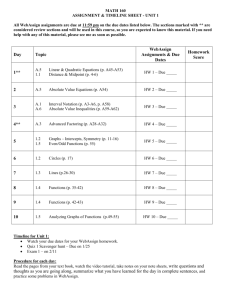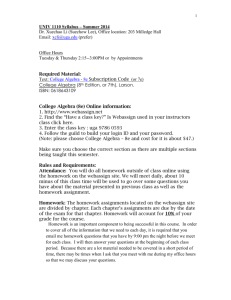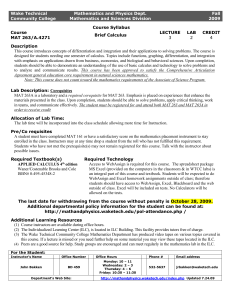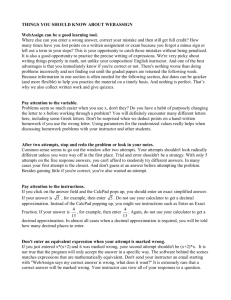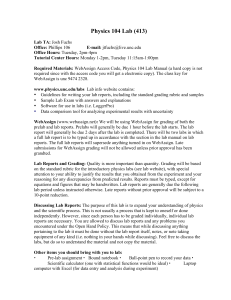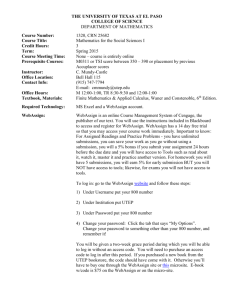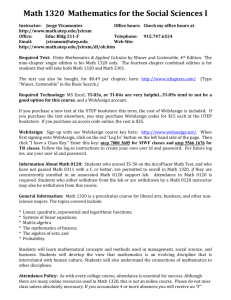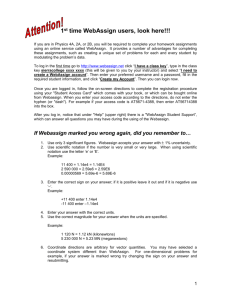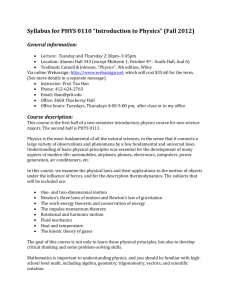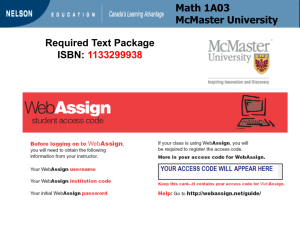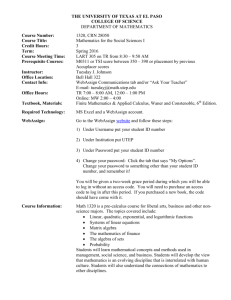Presentation
advertisement
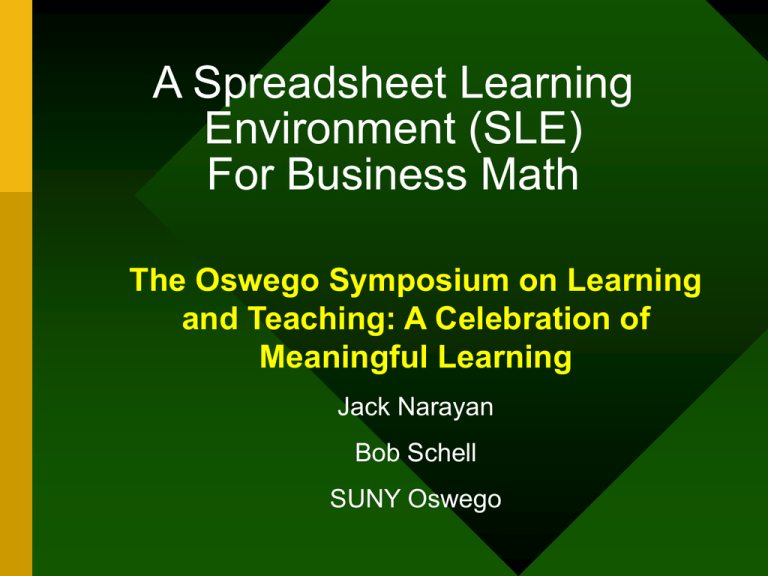
A Spreadsheet Learning Environment (SLE) For Business Math The Oswego Symposium on Learning and Teaching: A Celebration of Meaningful Learning Jack Narayan Bob Schell SUNY Oswego Our Challenge • Many College Students lack Quantitative Literacy (QL) • Dealing with Math Anxious Students • Satisfying Client departments Math 208 Topics • This is required course developed jointly by the School of Business and the Math Department. • Differential Calculus • Matrix Algebra and Linear Programming • Mathematics of Finance Math 208 Students • Many students put off taking this course until their junior and senior year • Weak in algebra and computational skills • Don’t like to write • Don’t read the textbook • Low attendance • Students want good grades Course Objectives include: • Cognitive gains and problems solving skills • Gains in self-efficacy • High levels of student engagement • Participation in collaborative learning • Write Math Explanations in Text Boxes in Excel Questions to Guide the Development of the SLE • How can we teach this course to be meaningful to the students? • How to get around the poor algebraic skills? • Can we get students to use the mathematics in other out of class situations? • Can technology be used effectively? Strategies • Just in time Algebra. Students forget • Focus on realistic problems • Appropriate use of technology • Interpret the mathematical results and communicate the ideas to others • Work in pairs or small groups. Student Engagement • Require students to have a laptop • Learn Excel. Use it as an educational Microworld to do mathematics. • Write up explanations in a text box • Use class management software WebAssign Excel Assignment on WebAssign Professor’s Tasks • Submit HW electronically every week • Grade electronic submissions manually or by WebAssign • Return grades next class period • Offer extra credit • Make attendance 10 % of the grade WebAssign •Readily available •Easy to use •Increases efficiency •Maintains contact with individual students Excel Assignment on WebAssign Alternative Approach • Does the data in this table reflect linear (quadratic, polynomial, exponential, logarithmic) growth? • How would you model this data? Write a paragraph describing the process. • Can you use your model to predict future values? Students learn: • To enter functions in a spread sheet • About domain (input) and range (output) • Compute “output values” for various “input values” • To use goal seek to find “input values” corresponding to “output values” • To plot graphs of functions Students learn about : • Max (Min) of f(x), intervals on which f(x) is increasing (decreasing), concavity, point of inflection; • Absolute Max (Min) • Fitting functions to real data • Predictions Excel helps with Problematic Topics • Profit = Revenue – Cost. • Factoring and expanding Algebraic expressions • Difference Quotient • Arithmetic Calculations Class at work What do they learn? • They achieve course objectives as measured with traditional examinations. • They increase their mathematical self-efficacy. • The are collaborative learners. • The are engaged in the classroom learning experience. The Plan Self-efficacy • More than 75% of students said that they had gained quite a bit or very much from their experience: – Q1g Increasing my ability to code information into a spreadsheet. – Q1i Increasing my ability to use a laptop computer. – Q1h Increasing my ability to interpret graphical information. – Q1c Increasing my ability to understand the ideas of business mathematics. Engagement • More than 50% of students said that they had engaged in these activities “often” or “very often”: – Q2f Received prompt feedback from you instructor on your academic performance, written or oral. – Q2d Worked with other students on assignments outside of class. – Q2c Worked harder than you though you could to meet the instructor's expectations. – Q2g Discussed ideas from your assignments or class outside of class (students, faculty, coworkers, others). Collaborative learning • More that 75% of students “agreed” or “strongly agreed”: – Q3b Using spreadsheets made it easier to understand the ideas of business mathematics. – Q3g I felt comfortable contacting the instructor in this course whenever I wished to so. – Q3e I would recommend this course, taught with spreadsheets, to other students. – Q3a This was an interesting math course. Collaborative learning • More that 75% of students “agreed” or “strongly agreed”: – Q3f The use of WebAssign facilitated my communication with the professor and increased my efficiency. – Q3h I felt that what I learned in this course was a partnership with the instructor. – Q3i I worked cooperatively with the other members of my group so that all of us stood a chance of getting a good grade in this course. Students’ Comments • I feel that I can add value to any situation that may call on my mathematical skills as a result of this new approach to calculus for business. • I have procrastinated taking this class, for fear of the ability to learn practical skills and the ability to learn and apply my experience. • I am more confident in my skills as a business professional. Conclusion Many Students are better at applying College Algebra after this class Most of them learn enough about Excel to do the mathematics they need in their areas of concentration. They saw value in what they did and worked hard in the course
